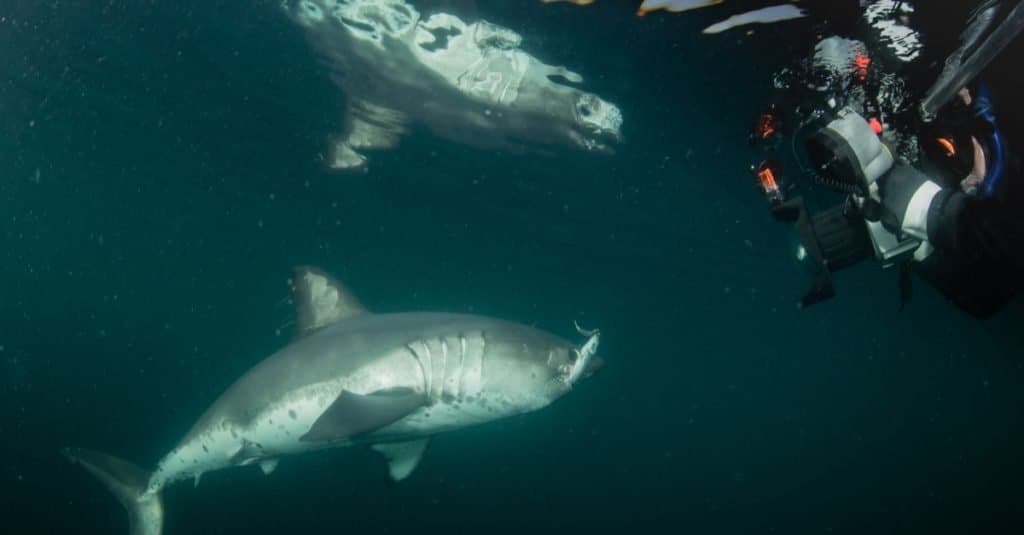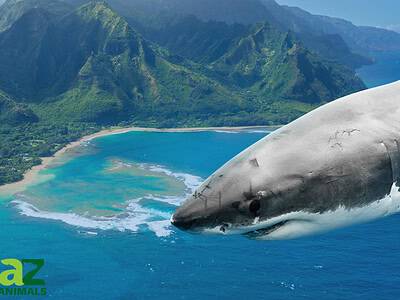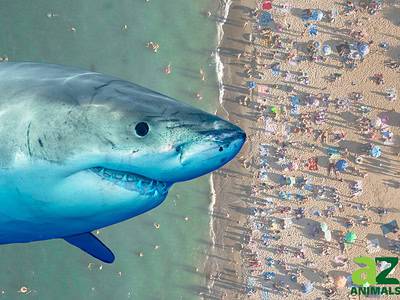Salmon Shark
Lamna ditropis
Salmon sharks are related to Great Whites.
Advertisement
Salmon Shark Scientific Classification
- Kingdom
- Animalia
- Phylum
- Chordata
- Class
- Chondrichthyes
- Order
- Lamniformes
- Family
- Lamnidae
- Genus
- Lamna
- Scientific Name
- Lamna ditropis
Read our Complete Guide to Classification of Animals.
Salmon Shark Conservation Status
Salmon Shark Facts
- Prey
- fish
- Group Behavior
- Solitary
- Fun Fact
- Salmon sharks are related to Great Whites.
- Estimated Population Size
- unknown
- Biggest Threat
- humans
- Most Distinctive Feature
- short snout, two keels
- Other Name(s)
- Pacific Porbeagle
- Gestation Period
- 9 months
- Habitat
- marine, ocean
- Predators
- humans, other sharks
- Diet
- Carnivore
- Type
- fish
- Common Name
- Salmon Shark
- Number Of Species
- 1
View all of the Salmon Shark images!
The Salmon shark is sometimes called “Pacific Porbeagle” because its appearance is almost indistinguishable from the porbeagle species.
In fact, before realizing it was a separate species, the salmon shark was incorrectly identified as a porbeagle. The salmon shark is also commonly mistaken for a great white shark and has been nicknamed “mini great white” due to their parallel comparisons. These sharks are not fished commercially but are frequently captured as bycatch and occasionally caught by recreational fishermen. Salmon sharks are migratory and are very fast swimmers.
5 Incredible Salmon Shark Facts!
- Baby sharks are called pups.
- Salmon sharks are a species of Mackerel shark.
- These sharks are endothermic.
- Salmon sharks’ reproduction is ovoviviparous.
- Embryos of these sharks feed on unfertilized eggs in the mother’s uterus.
Salmon Shark Classification and Scientific Name
The scientific name for this shark is Lamna ditropis. They are sometimes referred to as pacific porbeagle or mini great white. Salmon sharks are members of the Lamnidae family, otherwise known as mackerel sharks. They belong to Chondrichthyes which is a class of cartilaginous fishes that includes roughly 1,000 species of sharks, skates, and rays. The name Lamna ditropis is of Greek origin. Lamna means shark, while the meaning of di is two and tropis is defined as a keel.
Salmon Shark Species
There are only one species of these sharks. However, it is one of five living subspecies of mackerel sharks belonging to the Lamnidae family. The close relatives of the Salmon shark are listed below.
- Porbeagle (Lamna nasus)
- Great White (Carcharodon carcharias)
- Shortfin Mako (Isurus oxyrinchus)
- Longfin Mako (Isurus paucus)
Salmon Shark vs. Porbeagle
These sharks and Porbeagles are incredibly similar. A comparison of these two species, however, demonstrates the differences that distinguish them from one another. While they have a strikingly similar appearance, there are a couple of factors that separate the two. The main disparity in the comparison of these two species is their habitat. Salmon sharks inhabit the North Pacific and the Porbeagle occupies the North Atlantic. Another contrasting component between the species is their conservation status. Porbeagle sharks are a vulnerable species whereas Salmon sharks are not, being categorized as least concern.
Salmon Shark Appearance
These sharks have dark gray to black dorsal (upper side) coloring. The ventral (underside) is white with dark blotches. They have two dorsal fins and a crescent-shaped tail fin. Their skin is made up of dermal denticles, or placoid scales. Salmon sharks have sharp teeth and a blunt snout. They have large gill slits which they use to breathe. The average size of these sharks ranges from 6-10 feet in length and between 210 and 485 pounds, although they have been recorded at an impressive weight of 660 pounds. Female salmon sharks are generally larger in length and weight than males.
These sharks are endothermic, meaning they can regulate their body temperature to adapt to different temperatures in varying depths of water. They generally live in cold temperate waters around 34 degrees Fahrenheit. However, due to this unique survival adaptation, they can keep their body at higher temperatures than the water surrounding them.

©Warren Metcalf/Shutterstock.com
Salmon Shark Distribution, Population, and Habitat
It is difficult to pinpoint the number of these sharks in the wild today. According to the International Union for the Conservation of Nature, IUCN, the number was 16,600,000 to 21,900,000 in the year 1989. In the decades of 1950 and 1960, a substantial number of these sharks were reduced due to fisheries that did not continue into the 1990s. Between 1985 and 1995, as well as the 2000s, the population was noted as stable. The conservation status for salmon sharks is “Least Concern” on the IUCN red list.
These sharks live in marine saltwater habitats. Their range is in the oceanic, pelagic, and subtropical regions. They are native to the pacific ocean, Nearctic, and Palearctic. They inhabit areas of the ocean off of Canada, United States, Japan, North Korea, South Korea, and Russia. They are found at depths between 0 to 1,864 meters.
Salmon Shark Predators and Prey
These sharks are carnivores. These apex predators eat a variety of fish and tend to follow migratory patterns of some species they hunt often.
What eats Salmon Sharks?
Because of their size, these sharks have few natural predators. Humans are the only known predator of adults. Young sharks may fall prey to larger sharks.
What do Salmon Sharks eat?
As their name suggests, their main prey is salmon. They also feed on many other fish such as codfish, herring, sablefish, squid, steelhead trout, spiny dogfish, pollock, and more. Given the opportunity, these sharks will also attack and eat sea otters and some birds.
Salmon Shark Reproduction and Lifespan
Between late summer and early fall, these sharks migrate south to mate. Male sharks will mate with many females. To breed, the male will take hold of the female and insert his clasper into her cloaca. These sharks are ovoviviparous, meaning the fetuses develop inside eggs, within the body of the mother shark. The mother gives live birth to baby sharks, called pups when the embryo growth is complete. The length of the gestation period, similar to humans, is about nine months. In the spring, they will migrate back to their initial habitat and spawn two to five pups. The pups measure between 40 and 50 centimeters when they are born. Baby sharks receive parental care from their mother.
Male sharks reach sexual maturity at three to five years old while females are eight to ten years old when they fully mature. Female salmon sharks have a slightly shorter average lifespan than males. Females live up to 20 years and males live up to 27 years.
Salmon Shark in Fishing and Cooking
Commercial fisheries do not fish for these sharks but they are a common accidental bycatch. They are recognized by commercial fishermen as pests because they can damage their equipment and because they eat large numbers of the salmon they are after. Salmon sharks are sometimes sought after by recreational fishermen. According to the fishermen, a circle hook, a long wire leader, a heavy pound test line, and a strong reel are what you need to land a salmon shark.
Some humans in places such as Alaska, China, and Japan eat salmon sharks. People who enjoy this fish as a meal say it tastes similar to swordfish. On occasion, their fins are used for shark fin soup which is a traditional Chinese dish. Their hearts may be used in Japanese sashimi. Meat from these sharks can be marinated and grilled as steaks.
Some may wonder if you can keep this shark as a pet in a home aquarium. Truthfully, these apex predators would not be good pets. They would require a massive aquarium tank, among other special needs. There are some smaller shark species that would be better suited as a pet and could survive in an aquarium.
View all 292 animals that start with SSalmon Shark FAQs (Frequently Asked Questions)
What is a salmon shark?
A salmon shark is a species of mackerel shark that loves to feed on salmon.
Are salmon sharks dangerous?
The salmon shark is potentially dangerous due to its size. It is an apex predator.
Are salmon sharks related to great white sharks?
Yes, salmon sharks are in the same family as great white sharks.
Are salmon sharks edible?
When properly processed, salmon sharks can be eaten.
Has anyone ever been attacked by a salmon shark?
There have not been any documented salmon shark attacks on humans.
What is the difference between a salmon shark vs. great white?
Great whites are substantially larger than salmon sharks. Salmon sharks also have a shorter snout and dark blotches on their underside.
How cold is it where the salmon shark lives?
The salmon shark lives in waters around 34 degrees Fahrenheit.
Where are Salmon sharks found?
Salmon sharks are found in coastal and oceanic saltwater habitats.
Thank you for reading! Have some feedback for us? Contact the AZ Animals editorial team.
Sources
- Fishbase / Accessed July 2, 2021
- NOAA / Accessed July 2, 2021
- EOL / Accessed July 2, 2021
- Science Kids / Accessed July 2, 2021
- California Academy of Sciences / Accessed July 2, 2021
- Alaska Department of Fish And Game / Accessed July 2, 2021
- Marine Bio / Accessed July 2, 2021
- Shark Research Institute / Accessed July 2, 2021
- Florida Museum / Accessed July 2, 2021
- Angling Unlimited / Accessed July 2, 2021















